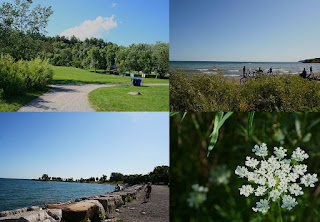Since we seem to be progressively traveling westward on the Waterfront trail these days, I thought I'd post a bit about the Rosetta McClain Gardens located about a kilometre west of the Scarborough Bluffs (Bluffers Park), just south of Kingston Road. Passing through the wrought iron gates of Rosetta McClain Gardens, you will enter into 40 acres of nostalgic history. You see, way back in 1904, Thomas McDonald West, owner and operator of the J & J Taylor Company had purchased the 40 acre farm overlooking Scarborough Bluffs. Thomas and his wife Emma had divided the land among their four children, Joseph McDonald, William Needham, Howard Thomas and Rosetta.



 Rosetta died close to Christmas of 1940 and left her husband behind for almost 20 years. During that time, her husband and brother had made many historical landscape improvements to the property that she loved so much. In 1959, her husband offered the property to the City of Toronto as parkland in her memory. In 1977 the land was conveyed the the Metropolitan Toronto and Region Conservation Authority and combined with portions of the J.M. and H.T. West property. Today, Toronto owns 23 acres of the historical landscape as part of its parks system. Of the 23 acres, you will find rock fountains, arranged as such to allow you touch the the cascading water, textured paths, scent gardens, raised planters, and of course unique gardens.
Rosetta died close to Christmas of 1940 and left her husband behind for almost 20 years. During that time, her husband and brother had made many historical landscape improvements to the property that she loved so much. In 1959, her husband offered the property to the City of Toronto as parkland in her memory. In 1977 the land was conveyed the the Metropolitan Toronto and Region Conservation Authority and combined with portions of the J.M. and H.T. West property. Today, Toronto owns 23 acres of the historical landscape as part of its parks system. Of the 23 acres, you will find rock fountains, arranged as such to allow you touch the the cascading water, textured paths, scent gardens, raised planters, and of course unique gardens. 
 On this particular day, there were wedding photographs being taken using the lush floral arrangements as backdrops. On the far southern point of the gardens you will see a beautiful view of the Scarborough bluffs from a clear vantage that will allow your imagination to slip back into a time when the family had owned a farm on the grounds. It must have been such an amazing place to live.
On this particular day, there were wedding photographs being taken using the lush floral arrangements as backdrops. On the far southern point of the gardens you will see a beautiful view of the Scarborough bluffs from a clear vantage that will allow your imagination to slip back into a time when the family had owned a farm on the grounds. It must have been such an amazing place to live.










